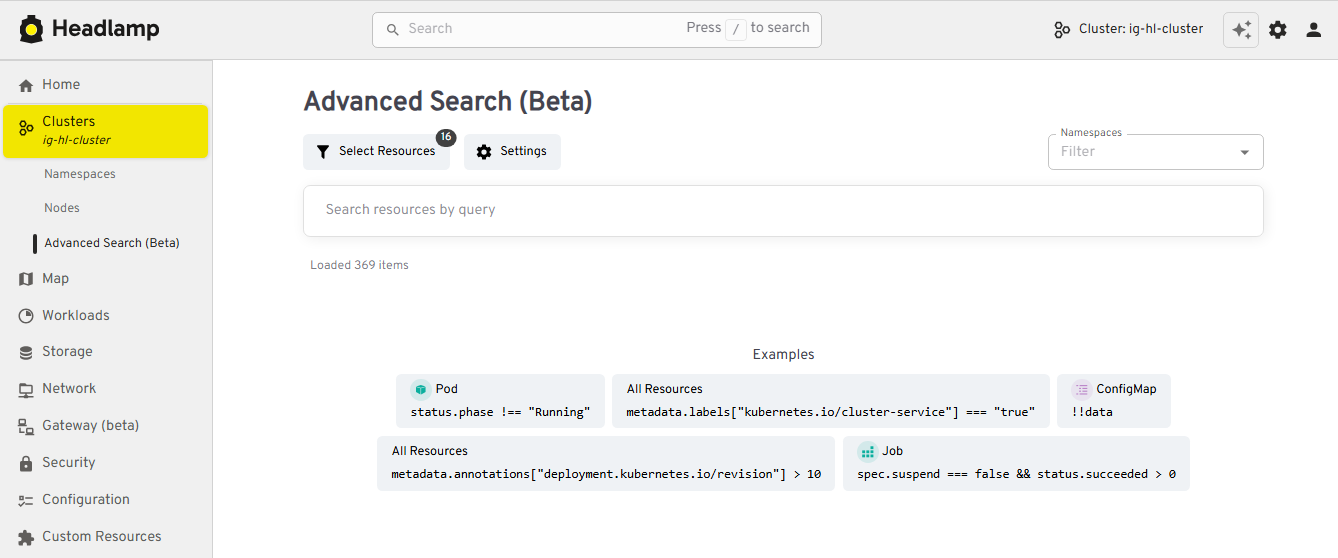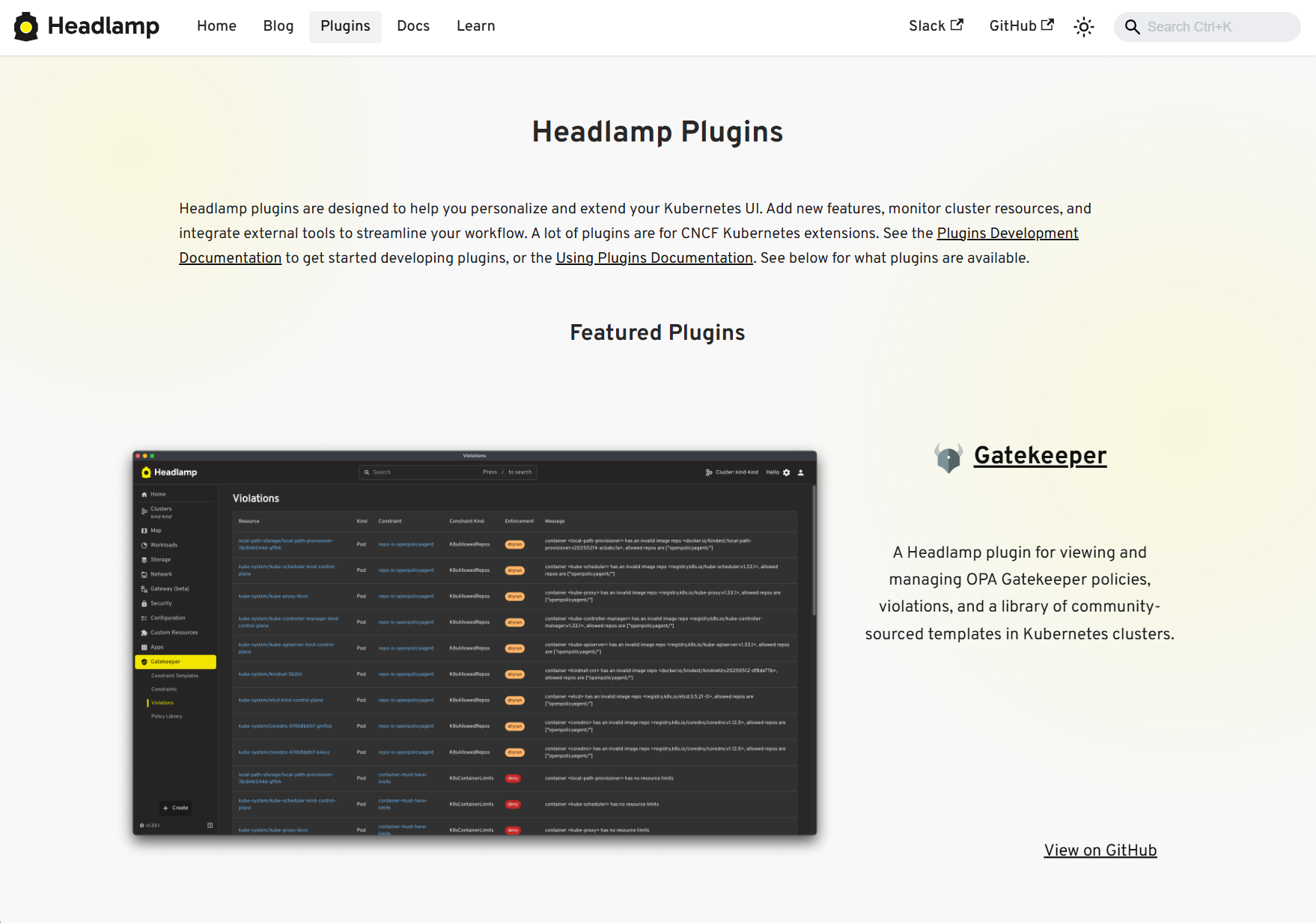
Headlamp in 2025: Project Highlights
KubeCon + CloudNativeCon North America 2025 has come to a close, and it was great seeing so many of you in Atlanta! Over the past year, Headlamp has continued to grow as a project: reaching more teams across platforms, powering new workflows and integrations through plugins, and seeing increased collaboration from the broader community.
Whether you caught our demos and sessions in person or are just catching up now, we wanted to give a few updates and highlight how Headlamp has evolved in 2025.
Updates
Joining Kubernetes SIG-UI
This year marked a big milestone for the project: Headlamp is now officially part of Kubernetes SIG-UI. This move brings roadmap and design discussions even closer to the core Kubernetes community and reinforces Headlamp’s role as a modern, extensible UI for the project.
As part of that, we’ve also been sharing more about making Kubernetes approachable for a wider audience, including an appearance on Enlightning with Whitney Lee and a talk at KCD New York 2025.
AKS Desktop Preview
Now in private preview is AKS Desktop, an application-centric experience addressing the complexity developers face when working with Kubernetes. Rather than troubleshooting setup, teams can quickly create and manage applications on Azure Kubernetes Service. Built on Headlamp’s intuitive interface, AKS Desktop combines supported and preconfigured AKS features so engineers can focus on building great solutions.
Sign up here to apply for the private preview for yourself.
Linux Foundation Mentorships
This year, we were excited to work with several students through the Linux Foundation’s Mentorship program, and our mentees have already left a visible mark on Headlamp:
- Adwait Godbole built the KEDA plugin, adding a UI in Headlamp to view and manage KEDA resources like ScaledObjects and ScaledJobs.
- Dhairya Majmudar set up an OpenTelemetry-based observability stack for Headlamp, wiring up metrics, logs, and traces so the project is easier to monitor and debug.
- Aishwarya Ghatole led a UX audit of Headlamp plugins, identifying usability issues and proposing design improvements and personas for plugin users.
- Anirban Singha developed the Karpenter plugin, giving Headlamp a focused view into Karpenter autoscaling resources and decisions.
- Aditya Chaudhary improved Gateway API support, so you can see networking relationships on the resource map, as well as improved support for many of the new Gateway API resources.
- Faakhir Zahid completed a way to easily manage plugin installation with Headlamp deployed in clusters.
- Saurav Upadhyay worked on backend caching for Kubernetes API calls, reducing load on the API server and improving performance in Headlamp.
New Changes
Multi-Cluster View
Managing multiple clusters is challenging: teams often switch between tools and lose context when trying to see what runs where. Headlamp solves this by giving you a single view to compare clusters side-by-side. This makes it easier to understand workloads across environments and reduces the time spent hunting for resources.

Projects
Kubernetes apps often span multiple namespaces and resource types, which makes troubleshooting feel like piecing together a puzzle. We’ve added Projects to give you an application-centric view that groups related resources across multiple namespaces – and even clusters. This allows you to reduce sprawl, troubleshoot faster, and collaborate without digging through YAML or cluster-wide lists.

Changes:
- New “Projects” feature for grouping namespaces into app- or team-centric projects
- Extensible Projects details view that plugins can customize with their own tabs and actions
Navigation & Activities
Day-to-day ops in Kubernetes often means juggling logs, terminals, YAML, and dashboards across clusters. We redesigned Headlamp’s navigation to treat these as first-class “activities” you can keep open and come back to, instead of one-off views you lose as soon as you click away.

Changes:
- A new task bar/activities model lets you pin logs, exec sessions, and details as ongoing activities
- An activity overview with a “Close all” action and cluster information
- Multi-select and global filters in tables
Thanks to Jan Jansen and Aditya Chaudhary.
Search & Map
When something breaks in production, the first two questions are usually “where is it?” and “what is it connected to?” We’ve upgraded both search and the map view so you can get from a high-level symptom to the right set of objects much faster.

Changes:
- An Advanced search view that supports rich, expression-based queries over Kubernetes objects
- Improved global search that understands labels and multiple search items, and can even update your current namespace based on what you find
- EndpointSlice support in the Network section
- A richer map view that now includes Custom Resources and Gateway API objects
Thanks to Fabian, Alexander North, and Victor Marcolino from Swisscom, and also to Aditya Chaudhary.
OIDC & Authentication
We’ve put real work into making OIDC setup clearer and more resilient, especially for in-cluster deployments.

Changes:
- User information displayed in the top bar for OIDC-authenticated users
- PKCE support for more secure authentication flows, as well as hardened token refresh handling
- Improved support for public OIDC clients (e.g., AKS and EKS)
- New guide for setting up Headlamp on AKS with Microsoft Entra ID using OAuth2 Proxy
Thanks to David Dobmeier and Harsh Srivastava.
App Catalog & Helm
We’ve broadened how you deploy and source apps via Headlamp, specifically supporting vanilla Helm repos.
Changes:
- A more capable Helm chart with optional backend TLS termination, PodDisruptionBudgets, custom pod labels, and more
- Improved formatting and added missing
-oidc-use-access-tokenarg in the Helm chart - New in-cluster Helm support with an
--enable-helmflag and a service proxy
Thanks to Vrushali Shah and Murali Annamneni from Oracle, and also to Pat Riehecky, Joshua Akers, Rostislav Stříbrný, Rick L, and Victor.
Performance, Accessibility, & UX
Finally, we’ve spent a lot of time on the things you notice every day but don’t always make headlines: startup time, list views, log viewers, accessibility, and small network UX details. A continuous accessibility self-audit has also helped us identify key issues and make Headlamp easier for everyone to use.

Changes:
- Significant desktop improvements, with up to 60% faster app loads and much quicker dev-mode reloads for contributors
- Numerous table and log viewer refinements: persistent sort order, consistent row actions, copy-name buttons, better tooltips, and more forgiving log inputs
- Accessibility and localization improvements, including fixes for zoom-related layout issues, better color contrast, improved screen reader support, and expanded language coverage
- More control over resources, with live pod CPU/memory metrics, richer pod details, and inline editing for secrets and CRD fields
- A refreshed documentation and plugin onboarding experience, including a “Learn” section and plugin showcase
- A more complete NetworkPolicy UI and network-related polish
- Nightly builds available for early testing
Thanks to Jaehan Byun and Jan Jansen.
Plugins & Extensibility
Discovering plugins is simpler now – no more hopping between Artifact Hub and assorted GitHub repos. Browse our dedicated Plugins page for a curated catalog of Headlamp-endorsed plugins, along with a showcase of featured plugins.

Headlamp AI Assistant
Managing Kubernetes often means memorizing commands and juggling tools. Headlamp’s new AI Assistant changes this by adding a natural-language interface built into the UI. Now, instead of typing kubectl or digging through YAML you can ask, “Is my app healthy?” or “Show logs for this deployment,” and get answers in context, speeding up troubleshooting and smoothing onboarding for new users. Learn more about it here.
New Plugins
Alongside the new AI Assistant, we’ve been growing Headlamp’s plugin ecosystem so you can bring more of your workflows into a single UI, with integrations like Minikube, Karpenter, and more.
Highlights from the latest plugin releases:
- Minikube plugin, providing a locally-stored single node Minikube cluster
- Karpenter plugin, with support for Azure Node Auto-Provisioning (NAP)
- KEDA plugin, which you can learn more about here
- Community-maintained plugins for Gatekeeper and KAITO
Thanks to Vrushali Shah and Murali Annamneni from Oracle, and also to Anirban Singha, Adwait Godbole, Sertaç Özercan, Ernest Wong, and Chloe Lim.
Other Plugin Updates
Alongside new additions, we’ve also spent time refining plugins that many of you already use, focusing on smoother workflows and better integration with the core UI.

Changes:
- Flux plugin: Updated for Flux v2.7, with support for newer CRDs, navigation fixes so it works smoothly on recent clusters
- App Catalog: Now supports Helm repos in addition to Artifact Hub, can run in-cluster via /serviceproxy, and shows both current and latest app versions
- Plugin Catalog: Improved card layout and accessibility, plus dependency and Storybook test updates
- Backstage plugin: Dependency and build updates, more info here
Plugin Development
We’ve focused on making it faster and clearer to build, test, and ship Headlamp plugins, backed by improved documentation and lighter tooling.

Changes:
- New and expanded guides for plugin architecture and development, including how to publish and ship plugins
- Added i18n support documentation so plugins can be translated and localized
- Added example plugins: ui-panels, resource-charts, custom-theme, and projects
- Improved type checking for Headlamp APIs, restored Storybook support for component testing, and reduced dependencies for faster installs and fewer updates
- Documented plugin install locations, UI signifiers in Plugin Settings, and labels that differentiated shipped, UI-installed, and dev-mode plugins
Security Upgrades
We've also been investing in keeping Headlamp secure – both by tightening how authentication works and by staying on top of upstream vulnerabilities and tooling.
Updates:
- We've been keeping up with security updates, regularly updating dependencies and addressing upstream security issues.
- We tightened the Helm chart's default security context and fixed a regression that broke the plugin manager.
- We've improved OIDC security with PKCE support, helping unblock more secure and standards-compliant OIDC setups when deploying Headlamp in-cluster.
Conclusion
Thank you to everyone who stopped by our booth, joined our sessions, or chatted with us during KubeCon + CloudNativeCon North America 2025. Seeing the different ways teams are adopting and extending the project is a big part of what keeps us moving forward.
If you’re catching up after the event, all these updates are available today. Try the latest Headlamp release, explore the new views, plugins, and docs, and share your feedback with us on Slack or GitHub – your feedback helps shape where Headlamp goes next.